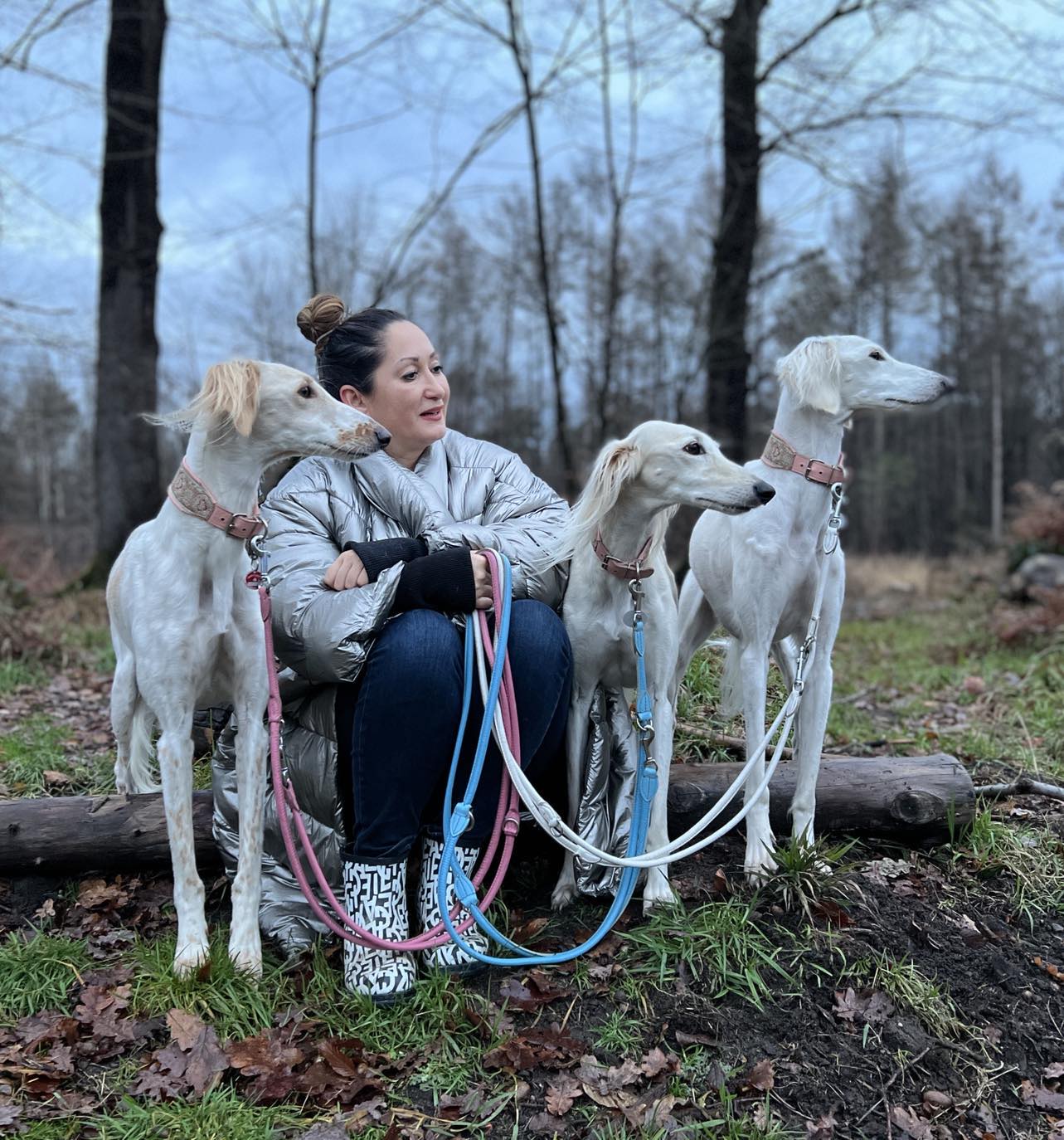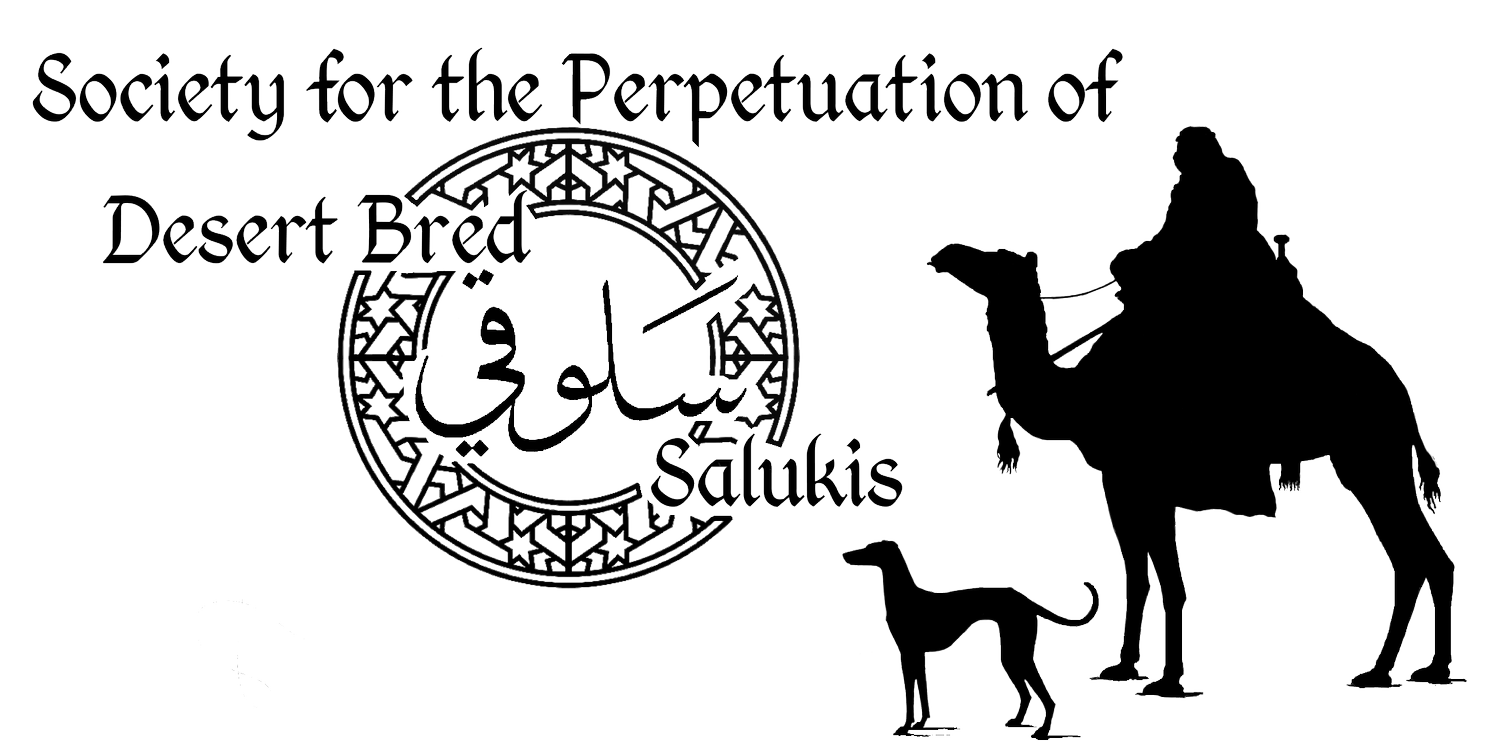
About the Saluki
The Saluki, also known as the Persian Greyhound, is undoubtedly one of the oldest domesticated dog breeds in the world. In its homeland (the Middle East), this dog is also commonly referred to as ‘Tazi.’ Salukis are native to Turkey,
Iraq, Iran, Syria, and Saudi Arabia. The muscular, slender Saluki embodies grace and harmony. Depending on its region of origin, the Saluki’s stature may vary, but generally, it possesses the typical appearance of a sighthound.
Living with Salukis means temporarily setting aside conventional ideas about dog training because the Saluki possesses an independent personality. Its natural independence doesn’t make it a trained soldier! The Saluki is an impressive
breed known for its sensitivity and speed. They are intelligent learners but can quickly become bored, especially if training becomes too repetitive.
The Saluki exhibits a pronounced independence, meaning it’s impossible to make them 100% obedient, and if so, it likely means they’ve been broken. Unlike many other breeds, they lack the strong ‘will to please.’ Some consider them
a bit stubborn, although that’s only partially true. With appropriate respect and patience, the Saluki can be effectively trained due to its quick comprehension and high intelligence.
Off-leash running can be a challenge due to their strong hunting instinct. Even with intensive training, it’s not guaranteed they’ll always respond when they spot an interesting prey like a hare. Among sighthounds, the Saluki possesses
considerable endurance. With enough exercise, they have a balanced and calm nature. They can satisfy their need for movement by running alongside a bicycle or in a secure area. However, their heart might race with passion when indulging
occasionally in lure coursing, a sport involving racing or coursing.
In lure coursing, an artificial hare lure is moved at high speed along a course using pulleys, simulating the movements of a fleeing hare. This encourages controlled expression of their hunting instincts.
When a Saluki feels lonely, it might express itself through a peculiar and melancholic song. Even within a pack or in the company of a musical person, they enjoy showcasing their musical side. Salukis are calm and unobtrusive companions.
They don’t require constant entertainment and don’t continuously seek attention. At home, Salukis are pleasant housemates.
They choose for themselves whom they want to form a close bond with. Sometimes their behavior resembles that of cats, as they appreciate affection but also enjoy their solitude if too much closeness becomes overwhelming.
SALUKI
FCI-Standard N° 269
ÜBERSETZUNG : Frau Ute Lennartz.
URSPRUNG : Mittlerer Osten / F.C.I. Patronat
DATUM DER PUBLIKATION DES GÜLTIGEN ORIGINALSTANDARDS : 25. 10. 2000.
VERWENDUNG : Jagd- und Coursinghund
KLASSIFIKATION F.C.I. : Gruppe 10 Windhunde
Sektion 1 Langhaarige und
befederte Windhunde
Ohne Arbeitsprüfung
KURZER GESCHICHTLICHER ABRISS : Salukis variieren im Typ und diese Variationsbreite ist erwünscht und typisch für die Rasse. Der Grund für die Typenvielfalt ist die besondere Stellung, die der Saluki in der arabischen Tradition einnimmt und die enorme Größe des Mittleren Ostens, in dem der Saluki als Hetzhund seit Tausenden von Jahren eingesetzt wurde. Ursprünglich besaß jeder Volksstamm Salukis , die sich am besten für die Jagd auf das spezielle Wild der Gegend eigneten, ohne daß – der Tradition des Mittleren Ostens entsprechend – Salukis verkauft oder gekauft, sondern als Ehrengabe verschenkt wurden. Die Folge war, daß solchermaßen den Europäern geschenkte und nach Europa gebrachten Salukis aus einem Gebiet mit einer großen Variationsbreite von Terrain und Klima stammten und sich dementsprechend unterschieden. Der britische Standard von 1923 war der erste offizielle europäische Rassestandard für den Saluki und wurde erstellt, um alle diese ursprünglichen Typen von Salukis zu erfassen.
ALLGEMEINES ERSCHEINUNGSBILD : Die ganze Erscheinung dieser Rasse soll einen Eindruck von Anmut und Ebenmaß, großer Schnelligkeit und Ausdauer, verbunden mit Kraft und Gewandtheit vermitteln.
Kurzhaarvarietät : in allen Merkmalen gleich, nur ohne Befederung.
WICHTIGE PROPORTIONEN
Die Rumpflänge (vom Buggelenk bis zum Sitzbeinhöcker) ist annähernd gleich der Widerristhöhe, obwohl der Hund oft den Eindruck vermittelt länger zu sein als er ist.
VERHALTEN UND CHARAKTER (WESEN) : Fremden gegenüber reserviert, jedoch nicht scheu oder aggressiv. Würdevoll, intelligent und unabhängig.
KOPF : Kopf lang and schmal, insgesamt viel Adel zeigend.
OBERKOPF
Schädel : Mäßig breit zwischen den Ohren, nicht gewölbt.
Stop : Nicht betont.
GESICHTSSCHÄDEL
Nase : Nasenschwamm schwarz oder leberfarben.
Kiefer/Gebiss : Starke Zähne und kräftige Kiefer mit einem perfekten, regelmäßigen und vollständigen Scherengebiß.
Augen : Dunkel –bis haselnußbraun, leuchtend, groß und oval, nicht hervortretend. Der Ausdruck ist würdevoll und sanft mit treuen, in die Ferne blickenden Augen.
Ohren : Lang und mit langen, seidigen Haaren bedeckt, hoch angesetzt, beweglich, dicht am Schädel getragen.
HALS : Lang, biegsam und gut bemuskelt.
KÖRPER
Rücken : Ziemlich breit.
Lenden : Leicht gewölbt und gut bemuskelt.
Kruppe : Weit auseinanderstehende Hüftbeinhöcker.
Brustkorb : Tief, lang und mäßig schmal, weder tonnenförmig noch flachrippig.
Unterlinie : Gut aufgezogen.
RUTE : Lang, tief angesetzt, in einem natürlichen Bogen getragen, an der Unterseite mit langen seidigen Haaren befedert, nicht buschig. Bei erwachsenen Hunden nicht höher als die Rückenlinie getragen, außer beim Spiel. Die Spitze der Rute sollte mindestens bis zum Sprunggelenk reichen.
GLIEDMASSEN
VORDERHAND
Schultern : Gut zurückliegend, gut bemuskelt, jedoch nicht grob.
Oberarm : Bei nahezu gleicher Länge wie das Schulterblatt bildet der Oberarm mit diesem einen guten Winkel.
Unterarm : Lang und gerade vom Ellbogen bis zum Vorderfußwurzelgelenk.
Vordermittelfuß : Kräftig und elastisch, von der Seite betrachtet wenig schräg gestellt.
Vorderpfoten : Von angemessener Länge, Zehen lang und gut gewölbt, nicht gespreizt, aber auch nicht wie Katzenpfoten; insgesamt kräftig und geschmeidig, zwischen den Zehen befedert.
HINTERHAND : Kräftig, läßt Gallopier- und Sprungvermögen erkennen.
Ober- und Unterschenkel : Gut entwickelt.
Kniegelenk : Mäßig gewinkelt.
Sprunggelenk : Gut tiefgestellt.
Hinterpfoten : Annähernd gleich den Vorderpfoten.
GANGWERK : Müheloser, flüssiger und geschmeidiger Trab. Leichtfüßig vom Boden abhebend, mit gutem Vortritt und entsprechendem Schub, weder steppend noch schwerfällig.
HAARKLEID
HAAR : Glatt und von weicher, seidiger Struktur. Befederung an den Läufen und an den Rückseiten von Ober- und Unterschenkel, Befederung an der Kehle von erwachsenen Hunden kann vorkommen, im Welpenalter besteht manchmal eine leichte, mehr wollige Befederung an Oberschenkeln und Schultern.
FCI-St Nr. 269
Die Kurzhaarvarietät : ohne jegliche Befederung.
FARBEN : Alle Farben oder Farbkombinationen sind zulässig. Brindle ist unerwünscht.
GRÖSSE
WIDERRISTHÖHE : Durchschnittlich zwischen 58 –71 cm (23-28 inches), Hündinnen proportional kleiner.
FEHLER : Jede Abweichung von den vorgenannten Punkten muß als Fehler angesehen werden, dessen Bewertung im genauen Verhältnis zum Grad der Abweichung stehen sollte.
Hunde, die deutlich physische Abnormalitäten oder Verhaltensstörungen aufweisen, müssen disqualifiziert werden.
N.B. : Rüden müssen zwei offensichtlich normal entwickelte Hoden aufweisen, die sich vollständig im Hodensack befinden.
SALUKI
FCI-Standard N° 269
Proposed by Mrs Karin Hedberg (Sweden),
Mrs Ute Lennartz
(Germany), Dr. Alain Campagne (France), Mr. Terry Thorn (Great-
Britain), Raymond Triquet, as President of the Standard Commission
of the F.C.I.
ORIGIN: Middle East / FCI Patronage.
DATE OF PUBLICATION OF THE OFFICIAL VALID
STANDARD: 25.10.2000.
UTILIZATION: Hunting and coursing hound.
FCI-CLASSIFICATION: Group 10 Sighthounds .
Section 1 Long haired or fringed
Sighthounds.
Without working trial.
BRIEF HISTORICAL SUMMARY:
Salukis vary in type and the variation is desired and typical for the breed. The reason for the variation is the special place held by the Saluki in the Arab tradition and the immense size of the Middle East area where the
Saluki has been used as a hound of the chase for thousands of years. Originally each tribe had Salukis best suited for hunting the particular game in its own area, but by Middle East tradition, Salukis are not bought or sold
but presented as marks of honour. It follows that those presented as such to Europeans and brought to Europe came from a wide variation of terrain and climate and vary accordingly. The British 1923 standard was the first
official European breed standard for the Saluki and was drawn up to cover all these original types of Saluki.
GENERAL APPEARANCE: The whole appearance of this breed should give an impression of grace and symmetry and of great speed and endurance coupled with strength and activity. Smooth variety:
the points should be the same with the exception of the coat which has no feathering.
IMPORTANT PROPORTIONS:
• The length of the body (from point of shoulder to point of buttock) is approximately equal to the height at the withers, although the dog often gives the impression of being longer than he really is.
BEHAVIOUR TEMPERAMENT: Reserved with strangers, but not nervous or aggressive. Dignified, intelligent and independent.
HEAD: Long and narrow, the whole showing nobility.
CRANIAL REGION:
Skull: Moderately wide between ears, not domed.
Stop: Not pronounced.
FACIAL REGION:
Nose: Black or liver brown.
Jaws/Teeth: Teeth and jaws are strong with a perfect, regular and complete scissor bite.
EYES: Dark to hazel and bright, large and oval, but not prominent. The expression should be dignified and gentle with faithful and far-seeing eyes.
EARS: Long and covered with long silky hair, set on high, mobile, hanging close to the skull.
NECK: Long, supple and well-muscled.
BODY:
Back: Fairly broad.
Loin: Slightly arched and well-muscled.
Croup: Hipbones set wide apart.
Chest: Deep, long and moderately narrow. Neither barrel ribbed nor slab sided.
Underline: Well tucked up.
TAIL: Long, set on low and carried naturally in a curve, well feathered on the underside with long silky hair, not bushy. In adults not carried above the topline except in play. Tip
reaching at least to the point of hock.
LIMBS
FOREQUARTERS:
Shoulder: Well laid back, well-muscled without being coarse.
Upper arm: Approximately equal in length to the shoulder blade and forming a good angle with it.
Forearm: Long and straight from elbow to wrist.
Pasterns: Strong and flexible, slightly sloping.
Forefeet: Feet of moderate length, toes long and well arched, not splayed, but at the same time not cat-footed; the whole being strong and supple; feathered between the toes.
HINDQUARTERS:
General appearance: Strong, showing galloping and jumping power.
Upper and lower thighs: Well developed.
Stifle: Moderately bent.
Hocks: Well let down.
Hind feet: Feet of moderate length, toes long and well arched, not splayed, but at the same time not cat-footed; the whole being strong and supple; feathered between the toes.
GAIT / MOVEMENT: Smooth, flowing and effortless at trot.
Light and lifting showing both reach and drive without hackney action or pounding.
COAT:
Hair: Smooth and of a soft, silky texture, feathering on the legs and at the back of thighs, feathering may be present on the throat in adults, puppies may have slight woolly feather on thighs and shoulders. The smooth variety
has no feathering.
Colour: Any colour or combination of colours is permissible. Brindles are undesirable.
SIZE:
Height at withers: Average between 58 – 71 cm (23-28 inches) bitches proportionally smaller.
FAULTS : Any departure from the foregoing points should be considered a fault and the seriousness with which the fault should be regarded should be in exact proportion to its degree and its effect upon the health and welfare of the dog.
DISQUALIFYING FAULTS:
• Aggressive or overly shy dogs.
• Any dog clearly showing physical of behavioural abnormalities.
N.B.:
• Male animals should have two apparently normal testicles fully descended into the scrotum.
• Only functionally and clinically healthy dogs, with breed typical conformation should be used for breeding.













